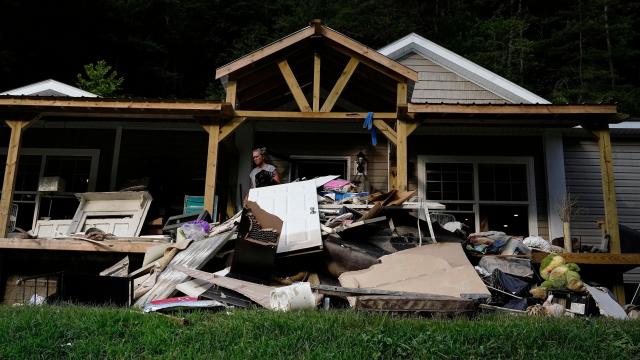It’s been a month and a half since devastating floods tore through Eastern Kentucky. A historic, so-called thousand-year rainfall overflowed rivers and streams, and it carried strip mining waste down into valley communities across the region.
At least 40 people were killed in the disaster, according to state Governor Andy Beshear. That death toll was revised as recently as this week — and the number could still continue to rise as others reportedly remain missing.
On top of the lives lost, the flooding also destroyed basic infrastructure and thousands of homes. President Joe Biden declared the Kentucky floods a major disaster and allocated Federal Emergency Management Agency (FEMA) funding to the recovery effort.
So far though, that aid has been difficult for people to access. Applications are getting stuck in the gears of bureaucracy, rejections abound, and the granted aid people have received thus far is often a pittance compared with the money actually needed to restore their permanent housing.
FEMA reported that it has approved 7,348 individual assistance applications from Easter Kentucky, and distributed more than $US54.6 ($76) million in housing assistance, as of Wednesday. However, that represents only about half of the more than 13,600 households that have applied for assistance from the agency, according to Justin Hicks, a Kentucky-based journalist.
The rate of approved applications has inched upwards since the beginning of September, Hicks pointed out in a tweet. However, the median award for each fulfilled application thus far is only a few thousand dollars, much too little to allow most to rebuild, recover, or relocate. Just 336 households have been granted the maximum amount allowed (about $US38,000 ($52,752)) for housing assistance, as of Sunday, according to Hicks.
In response to complaints about supposed unjustified denials, FEMA did announce a few changes to speed up the application process last month. Some of these shifts included on-site benefits approval, and text communications, according to reporting from Ohio Valley Resource, a local non-profit news outlet. Yet it’s unclear how much of an improvement, if any, has resulted.
The agency also stressed that people approved for very small grants, some less than $US200 ($278), should keep appealing and applying for more funds. “If they get a check for only $US179 ($248) that is just an initial [aid payment],” said Brett Howard, FEMA’s federal coordinating officer, in a press call earlier this month, according to a report from Government Technology.
Those small amounts can theoretically be used to help jump-start the process of hiring contractors or getting inspections and estimates done on damaged homes, said FEMA in a press release. “Once a survivor has their estimate in hand, they can file an appeal for possible additional funding,” the statement said.
Yet that multi-step, multi-application process is part of the problem for some, who are too preoccupied with just trying to get by in the disaster’s wake, to keep up with all the paperwork. “FEMA’s little bit slow on helping us,” Laverne Fields, a flood survivor currently living in camper, said to Ohio Valley Resource, in another report.
From the outlet:
She’s too busy to appeal with FEMA right now. Fields lives with nine people: her brother, her cousins, her niece, some kids from other families she’s taking care of. There’s no electricity or running water in the camper.
Gov. Beshear also voiced criticism of FEMA’s response back in August. “Too many people are being denied, not enough people are being approved, and this is the time that FEMA has to get it right. To change what has been a history of denying too many people, and not providing enough dollars, and to get it right here,” he said.
Separately, state legislators introduced and passed a $US213 ($296) million relief bill. But did not include a proposed $US50 ($69) million amendment for temporary housing and the bill also lacked funds for long-term housing solutions.
Church groups and some sectarian disaster relief non-profits have converged on the region, to try to offer help fill in the gaps. More than 6,000 households have applied to receive assistance from the Foundation for Appalachian Kentucky, the non-profit’s chief strategist, Laura Smith, told BBC World in a podcast episode. However, many organisations on the ground are still struggling to fulfil the need. And local residents are left wondering what they’re going to do through the coming winter and beyond.
Decades of ecologically destructive mining coupled with more severe storms brought on by climate change have left Eastern Kentucky one of the many regions of the world vulnerable to increasingly extreme floods. What may have once been a thousand-year rainfall probably isn’t anymore. What happened this past July is likely to happen again.
“We all want to rebuild. We all love here,” said Willa Johnson, another flood survivor, to BBC World. “But there is a part of me that just questions how we rebuild if we can’t go higher. Because once a flood line happens, it changes your landscape, it changes what’s possible the next time and no part of me wants to be near the creek or the river again.”
